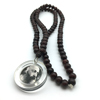Pilgrimage

Ghoshen talks about the TV series ‘Sacred Journeys’ and the film ‘The Way’ – and about pilgrimage in various cultures.
I have been thinking a lot recently about pilgrimage. It is, after all, a part of many religious and spiritual traditions and one that remains popular, perhaps surprisingly so, in our modern world. Indeed, two forms of pilgrimage prompt the largest gatherings of human beings in the world today, the Islamic Hajj and the Kumbh Mela of the Hindus. An estimated 120 million people visited the Maha Kumbh Mela in 2013 in Allahabad while the Hajj draws around 2 million every year. In the 1970s, when I journeyed to Pune to be with Osho, I did not think of the trips as pilgrimages and yet, looking back now, it seems appropriate to call them such. We might do well to note that the words ‘sannyasin’ and ‘pilgrim’ have some significant overlap in meaning.
Pilgrimage has long been a fertile source of narratives, from Chaucer’s The Canterbury Tales to contemporary films and television fare, and two of the latter are my focus here. Sacred Journeys is a six-part documentary series made for PBS television in the U.S. by a Bruce Feiler while The Way is a dramatic movie starring Martin Sheen.
Sacred Journeys, which can be found free on YouTube, devotes a one-hour program to each of six pilgrimages. The most interesting of them for many of us will be the one about the Hajj because it is something that millions of people participate in and yet is strictly unavailable to those of us who are not Muslims. Indeed it was not available even to Bruce Feiler and, for that one case, he had a proxy do the reporting on it. The Hajj is also the most ritualistic of the six and one that, despite several tragic accidents in recent years, is organized with impressive logistics. My second favourite took as its subject the Kumbh Mela. This takes place every four years and is by far the largest human gathering. I was impressed once more by how well organized it is. It might be crowded and dirty but I suspect it could be a lot of fun. Third on my list is the Buddhist pilgrimage around the Japanese island of Shikoku, a 750-mile walking trail on which pilgrims visit 88 temples, each with a connection to the monk and teacher Kobo-Daishi who is the most revered figure in Japanese Buddhism. This is the one pilgrimage I would really like to do, not for any Buddhist purpose, but because it promises to be a very pleasant walk around a beautiful island that I have visited in the past. The remaining episodes treat Jerusalem, Lourdes and the festival that takes place every year in Osogbo, Nigeria, to celebrate the goddess of fertility, Osun. All together, Sacred Journeys does a fine job of illuminating six festivals or pilgrimages that are of powerful religious and spiritual significance to their participants, albeit with a pronounced American take on things.
Probably the most significant pilgrimage that Sacred Journeys does not include is that to Santiago de Compostela in Spain. The cathedral in Santiago houses a shrine to the Apostle James that claims to include his remains. Pilgrims have made their way to this shrine for centuries, traveling over various established routes, and continue to do so today. The most important route is from France where paths start at several locations, including Paris, and converge into one after crossing the Pyrenees. Some pilgrims do the journey by bicycle and some on horseback but the majority do it on foot. In the movie The Way the main character is played by Martin Sheen and starts when his son, played by Sheen’s own son Emilio Estevez, sets out to walk “The French Way” as the route is called. The father does not understand why his son wants to undertake this pilgrimage but, after the son perishes in a storm high in the Pyrenees near the very start of his walk, he decides to take it upon himself to complete the walk in honour of his son. Sheen’s character is a rather crotchety fellow who, in spite of this, teams up with three other pilgrims along the way. We see the joys and hardships of their journey. The hardships include sleeping in dormitories (which many do but which presumably is not a requirement – indeed a few luxury boutique accommodations have opened recently, specifically for more well-to-do pilgrims). The joys include walking through beautiful scenery, savouring Spanish cuisine, visiting spectacular towns that lie along the route, notably León, and perhaps best of all enjoying the camaraderie among fellow pilgrims. Interestingly, none of the four pilgrims that the film focuses on is doing the walk for any religious reasons. They do however have their reasons and we learn that some find the outcome they desired while others do not.
For reference I will mention a couple of other films. Probably the best known film about pilgrimage is Luis Bunuel’s The Milky Way from 1969 which is also about the “Way of St. James”. I saw this many years ago, was impressed by it but barely remember it now. Then there is a short (20-minute) documentary from 2001, Pilgrimage, by one of my favourite film-makers, Werner Herzog. While very well made, it is heavy, focusing on Christian pilgrims, many of them ill or infirm, making their way to shrines on their knees. It is also available on YouTube.
Ghoshen is a regular contributor to this magazine
- Log in to post comments
- 30 views
